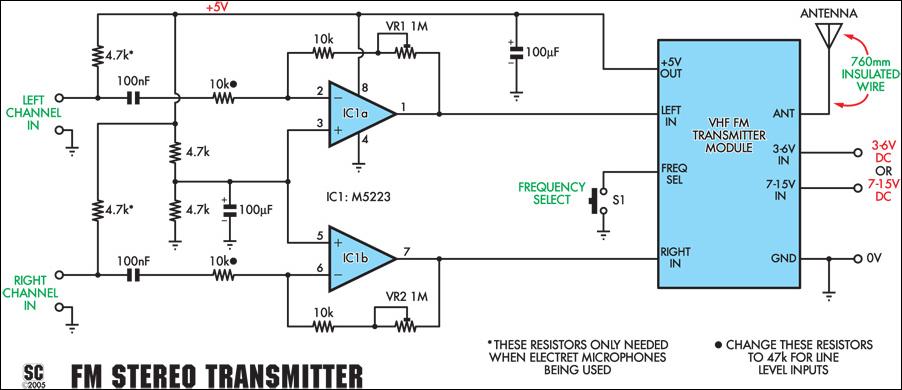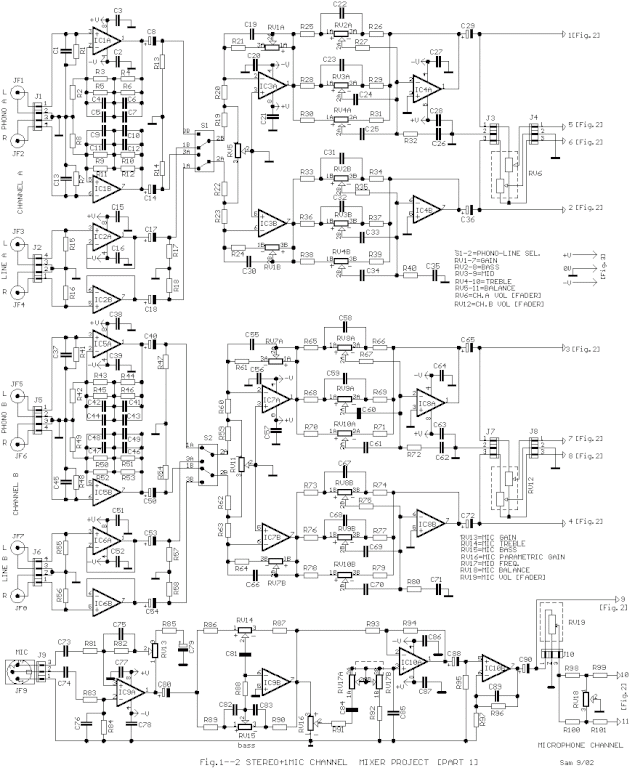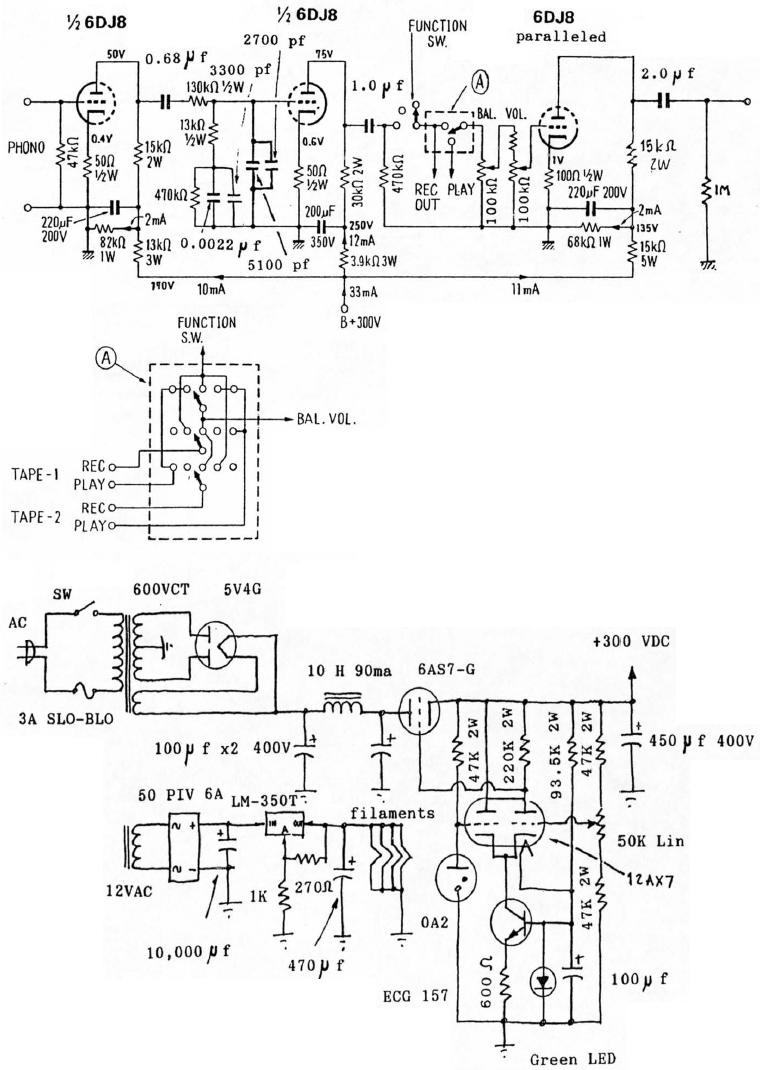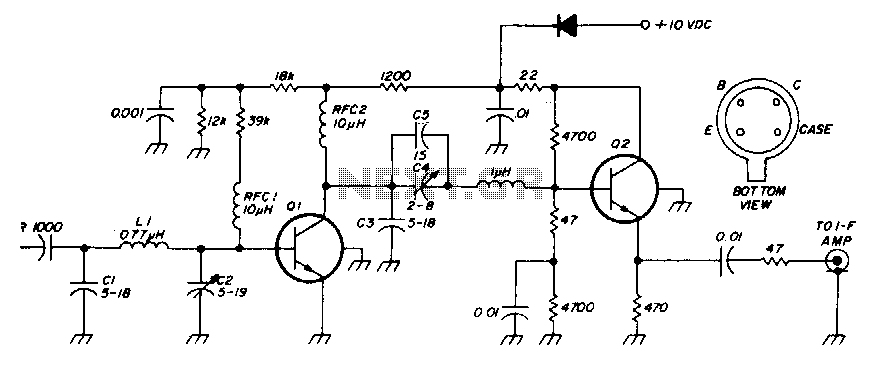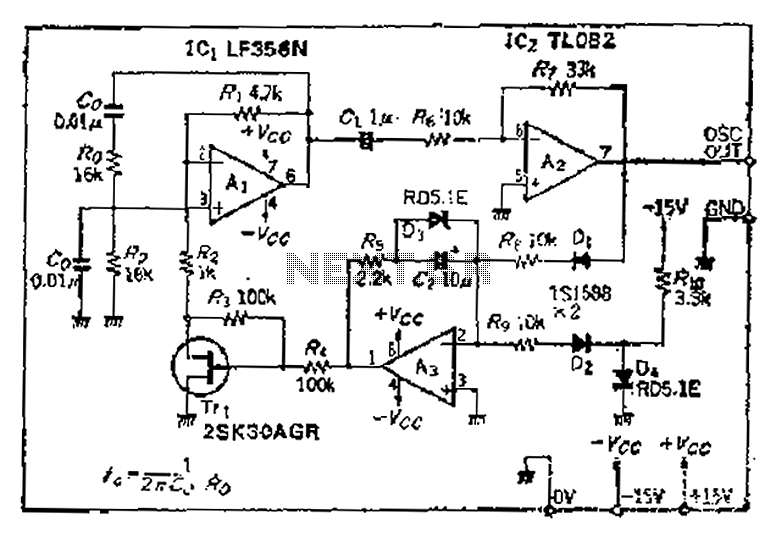
PC Microphone Preamplifier

Soundblaster soundcard series (SB16, SB32, AWE32 and AWE64) have all a microphone input designed to be used with the electret microphones which come with the soundcard package (some packages) or with separate microphone designed to be used with SoundBlaster soundcards (there are separate microphones and some monitors have built-in microphones like this). Because the microphone input needs very high input levels it is not suitable to be used with any other microphone type than electret capsule microphones. If you connect a dynamic microphone (which gives typically few mV voltage) and try to record it you will get very low signal level with lots of noise. More: Dynamic microphones can be connected to SoundBlaster if a suitable microphone preamplifier is built which can amplify the signal levels from dynamic microphones so much that they give enough level for SoundBlaster. This circuit gives amplification of about 30-50 which is enough to make the signals from dynamic microphones enough high to be handled well by SoundBlaster. The circuit is very simple so the amplification is not accurately defined (depends on transistor parameters which can vary from transistor to transistor) and other performance figures are not the best possible. The circuit has a very nice feature that it does not need any external power supply because it uses the bias voltage (+5V) which SoundBlaster sends normally to the electric microphone as its power source. I have used this circuit successfully with AKG D 60 S dynamic microphone and Sound Blaster 16. Using this circuit you can add better microphones than those cheap multimedia microphones to your soundcards quite easily. With all SoundBlasters a better microphone is not yet a guarantee for better sound quality because the poor frequency response of the microphone preamplifier in SB16 cards. If you want even better sound quality you might consider building a simple microphone preamplifier design and connect it to the line level input of your SoundBlaster. R1 1 kohm R2 220 kohm R3 4.7 kohm C1 15 uF 10V electrolytic (you use 10 uF or 22 uF if you can't find 15 uF easily) C2 22 uF 10V electrolytic C3 47 uF 10V electrolytic Q1 BC547B
The Soundblaster soundcard series, including models SB16, SB32, AWE32, and AWE64, features a microphone input specifically designed for electret microphones. These microphones may be included with the soundcard package or purchased separately, and some monitors are equipped with built-in microphones compatible with SoundBlaster soundcards. The microphone input requires high input levels, making it unsuitable for dynamic microphones, which typically produce low voltage signals (a few millivolts). Attempting to use a dynamic microphone directly with the SoundBlaster will result in low signal levels accompanied by significant noise.
To facilitate the use of dynamic microphones with SoundBlaster soundcards, a dedicated microphone preamplifier circuit can be constructed. This circuit is designed to amplify the low signal levels from dynamic microphones to an adequate level that the SoundBlaster can process effectively. The expected amplification factor of the circuit ranges from 30 to 50, which sufficiently raises the signal levels for compatibility with the soundcard's input requirements. It is important to note that the amplification is not precisely defined due to variations in transistor parameters, which can differ from one unit to another.
A notable advantage of this preamplifier circuit is its ability to operate without an external power supply. It utilizes the bias voltage (+5V) typically supplied by the SoundBlaster to power electret microphones. This feature simplifies the design and enhances convenience. The circuit has been successfully tested using the AKG D 60 S dynamic microphone in conjunction with the Sound Blaster 16.
While this circuit allows for the integration of higher-quality microphones than standard multimedia options, it is essential to recognize that improved microphones do not guarantee superior sound quality due to the limitations of the microphone preamplifier in certain SoundBlaster models, particularly the SB16. For those seeking enhanced audio fidelity, it may be advisable to construct a more sophisticated microphone preamplifier and connect it to the line-level input of the SoundBlaster.
The components for the preamplifier circuit are as follows:
- R1: 1 kΩ
- R2: 220 kΩ
- R3: 4.7 kΩ
- C1: 15 µF, 10V electrolytic (alternatively, 10 µF or 22 µF may be used if 15 µF is unavailable)
- C2: 22 µF, 10V electrolytic
- C3: 47 µF, 10V electrolytic
- Q1: BC547B transistor
This circuit effectively enhances the functionality of SoundBlaster soundcards by enabling compatibility with a broader range of microphones, particularly dynamic types, thereby improving recording quality.Soundblaster soundcard series (SB16, SB32, AWE32 and AWE64) have all a microphone input designed to be used with the electret microphones which come with the soundcard package (some packages) or with separate microphone designed to be used with SoundBlaster soundcards (there are separate microphones and some monitors have built-in microphones like this). Because the microphone input needs very high input levels it is not suitable to be used with any other micophone type than elecret capsule microphones.
If you connect a dynamic microphone (which gives typically few mV voltage) and try to record it you will get very low signal level with lots of noise. Dynamic microphones can be connected to SoundBlaster if a suitable microphone preamplifier is built which can amplify the signal levels from dynamic microphones so much that they give enough level for SoundBlaster. This circuit gives amplification of about 30-50 which is enough to make the signals from dynamic microphones enough high to be handled well by SoundBlaster.
The circuit is very simple so the amplification is not accurately defined (depends on transistor parameters which can vary from transistor to transistor) and other performance figures are not the best possible. The circuit has a very nice feature that it does not need any external power supply because it uses the bias voltage (+5V) which SoundBlaster sends normally to the electric microphone as it's power source.
I have used this circuit succesfully with AKG D 60 S dynamic microphone and Sound Blaster 16. Using this circuit you can add better microphones than those cheap multimedia microphones to your soundcards quite easily. With all SoundBlasters a better microphone is not yeat a guarantee for better sound quality because the poor frequency response of the microphone preamplifier in SB16 cards.
If your want even better sound quality you might consider building by simple microphone preamplifier design and connect it to the line level input of your SoundBlaster. R1 1 kohm R2 220 kohm R3 4.7 kohm C1 15 uF 10V electrolytic (you use 10 uF or 22 uF if you can't find 15 uF easily) C2 22 uF 10V electrolytic C3 47 uF 10V electrolytic Q1 BC547B
🔗 External reference
The Soundblaster soundcard series, including models SB16, SB32, AWE32, and AWE64, features a microphone input specifically designed for electret microphones. These microphones may be included with the soundcard package or purchased separately, and some monitors are equipped with built-in microphones compatible with SoundBlaster soundcards. The microphone input requires high input levels, making it unsuitable for dynamic microphones, which typically produce low voltage signals (a few millivolts). Attempting to use a dynamic microphone directly with the SoundBlaster will result in low signal levels accompanied by significant noise.
To facilitate the use of dynamic microphones with SoundBlaster soundcards, a dedicated microphone preamplifier circuit can be constructed. This circuit is designed to amplify the low signal levels from dynamic microphones to an adequate level that the SoundBlaster can process effectively. The expected amplification factor of the circuit ranges from 30 to 50, which sufficiently raises the signal levels for compatibility with the soundcard's input requirements. It is important to note that the amplification is not precisely defined due to variations in transistor parameters, which can differ from one unit to another.
A notable advantage of this preamplifier circuit is its ability to operate without an external power supply. It utilizes the bias voltage (+5V) typically supplied by the SoundBlaster to power electret microphones. This feature simplifies the design and enhances convenience. The circuit has been successfully tested using the AKG D 60 S dynamic microphone in conjunction with the Sound Blaster 16.
While this circuit allows for the integration of higher-quality microphones than standard multimedia options, it is essential to recognize that improved microphones do not guarantee superior sound quality due to the limitations of the microphone preamplifier in certain SoundBlaster models, particularly the SB16. For those seeking enhanced audio fidelity, it may be advisable to construct a more sophisticated microphone preamplifier and connect it to the line-level input of the SoundBlaster.
The components for the preamplifier circuit are as follows:
- R1: 1 kΩ
- R2: 220 kΩ
- R3: 4.7 kΩ
- C1: 15 µF, 10V electrolytic (alternatively, 10 µF or 22 µF may be used if 15 µF is unavailable)
- C2: 22 µF, 10V electrolytic
- C3: 47 µF, 10V electrolytic
- Q1: BC547B transistor
This circuit effectively enhances the functionality of SoundBlaster soundcards by enabling compatibility with a broader range of microphones, particularly dynamic types, thereby improving recording quality.Soundblaster soundcard series (SB16, SB32, AWE32 and AWE64) have all a microphone input designed to be used with the electret microphones which come with the soundcard package (some packages) or with separate microphone designed to be used with SoundBlaster soundcards (there are separate microphones and some monitors have built-in microphones like this). Because the microphone input needs very high input levels it is not suitable to be used with any other micophone type than elecret capsule microphones.
If you connect a dynamic microphone (which gives typically few mV voltage) and try to record it you will get very low signal level with lots of noise. Dynamic microphones can be connected to SoundBlaster if a suitable microphone preamplifier is built which can amplify the signal levels from dynamic microphones so much that they give enough level for SoundBlaster. This circuit gives amplification of about 30-50 which is enough to make the signals from dynamic microphones enough high to be handled well by SoundBlaster.
The circuit is very simple so the amplification is not accurately defined (depends on transistor parameters which can vary from transistor to transistor) and other performance figures are not the best possible. The circuit has a very nice feature that it does not need any external power supply because it uses the bias voltage (+5V) which SoundBlaster sends normally to the electric microphone as it's power source.
I have used this circuit succesfully with AKG D 60 S dynamic microphone and Sound Blaster 16. Using this circuit you can add better microphones than those cheap multimedia microphones to your soundcards quite easily. With all SoundBlasters a better microphone is not yeat a guarantee for better sound quality because the poor frequency response of the microphone preamplifier in SB16 cards.
If your want even better sound quality you might consider building by simple microphone preamplifier design and connect it to the line level input of your SoundBlaster. R1 1 kohm R2 220 kohm R3 4.7 kohm C1 15 uF 10V electrolytic (you use 10 uF or 22 uF if you can't find 15 uF easily) C2 22 uF 10V electrolytic C3 47 uF 10V electrolytic Q1 BC547B
🔗 External reference
